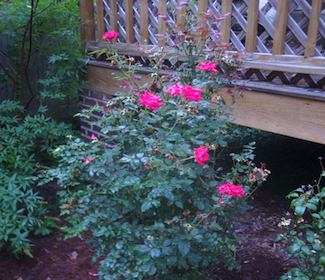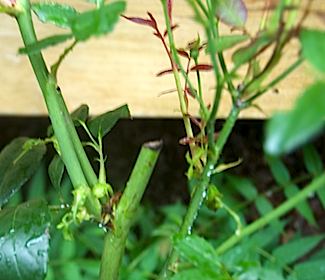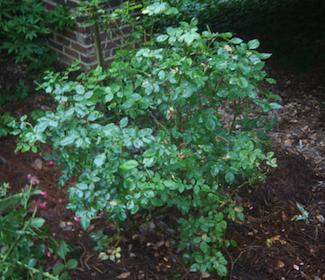Pruning Roses

Pruning Roses - Rose Bush In Need of Pruning
Roses are one of the most popular flowers for home gardeners, but they aren't always the easiest to care for. Bushes growing out of control, fewer blooms than anticipated, and uneven growth are all common issues for growers, but they can all be solved with a good pruning.
Before you grab your hedge clippers and go to town on your rose bushes, you need to know that simply chopping the growth back into a nice looking shape is not the solution to your rose issues.
Haphazardly cutting your bushes into a shape that looks nice is actually one of the worst things you could do to your plants, because it is non-selective in nature. This 'hedge clipper' method can also introduce insect and disease damage that can harm, and eventually kill, your prized roses.

Pruning Roses - Example of Bad Prune Job
Pruning Roses - The Analysis:
Before you start pruning your roses, it's a good idea to take the time to assess each bush to decide how best to prune it for optimum growth, health, and appearance. Here are a few things to consider:
Pruning Roses - Shoot Growth: Is the rose bush full in appearance with several canes sticking far above the main form of the bush? If so, the most appropriate measure is to trim off these canes to bring the bush back into form. For instructions on the actual pruning process, see the section below on "How to Prune."
Pruning Roses - Dead Growth: If your rose bush has dead areas, or canes that have very little if any foliage on it, cut these limbs all the way down to the base of the plant. Doing this will improve the plants' health, give it added vigor, and increase air flow to the center of the plant. Doing this also reduces the likelihood of fungus or mildew buildup, which can further damage the plant.
Pruning Roses - Leggy, Out of Form Bush: This situation presents one of the more serious pruning issues, and often requires the most extreme pruning measures, in that a large portion of the plant may need to be removed. Usually these bushes are very thin and lack the full appearance of a healthy bush. Cutting back such a large amount of the bush may alarm you, but afterwards there should be plenty of new canes, and they should then be kept to a uniform growth.
Pruning Roses - When Should You Prune? Where you reside can affect pruning times, but for most areas, the best time to prune roses is late winter. In cold weather states, early spring is the best time, before the plants start blooming. If you need to prune during other times of the year, keep an eye on the growth of the flower buds. When they begin to swell, that's the time to prune.
The Purpose For Pruning:

Pruning Roses - Example of a Proper Cut
The main reason for rose pruning is obviously to bring the bush back into form and looking like a well-mannered member in your flower garden. There are other important reasons for pruning roses; to encourage new growth, increase the density of the bush, and to force additional blooms in the next growing season. By removing excess dead or dying canes, the overall health and disease resistance of the bush will improve.
Pruning Roses - Tools Required:
There's really only one tool needed for pruning roses; a high-quality manual hand pruning shears. At Green Home Landscape Source, there's only one type of shear we use and recommend, the Felco F-2 Classic By-Pass Hand Pruner. It's extremely sharp, provides a knife-edged cut, is easy to use, and will last forever. All you need to do is keep it clean, and keep it sharp.
The Felco pruner will handle any rose bush cane. If you have a rose variety with larger canes that will give a hand trimmer difficulty, you may also want a high-quality by-pass loppers. These can handle rose canes up to 1" or more in diameter. Don't ever use any type of anvil type pruners or loppers, as these will damage the bush by crushing the canes instead of slicing through them cleanly.
Rose bushes have sharp thorns that will get you sooner or later, regardless of how careful you are. Long sleeves, long pants, and a good pair of leather garden gloves will keep those nasty "got ya" pricks to a minimum.
Pruning Roses - Steps to Do It:

Pruning Roses - Example of a Cut at a Bud Union
- Determine the shape and form you want the rose bush to have.
- Start by removing any dead canes by cutting them down close to ground level. Healthy canes will be green or slightly cream-colored; dead and dying canes will be brown to black, with shriveled-looking canes.
- Remove any suckers that are growing off the roots of the plant. These suckers "suck" vital nutrients away from the parent or host plant, and will steal vigor from the plant. To remove them, dig around the sucker to find where they are sprouting from the roots. Cut them off close to the root and cover the area with soil.
- To trim healthy green or cream-colored canes: Decide on the desired height you wish to achieve for your plant. Pruning should take place just above a healthy growth shoot on the cane. Make the cut as close to this shoot as possible, with the cut angling slightly downward. This is an important part of a proper cut, as any 'stub', even as small as 1/4", will invite disease to the cut.
- For a more aggressive pruning job, you may not find a growth sprout further down on the canes. In this case, prune just above a bud union, which will appear as a slight swelling in the cane. It looks like a seam in the cane where it's joined together.
- To encourage new growth and more flowers, you may want to remove dead blooms as they begin to fade. This encourages more energy to be directed to new flower growth. This is known as "dead-heading."
- If your rose bush has partially dead canes that are diseased or are dying above an otherwise healthy cane, prune away the entire dead or dying area from the dead area down to the first bud union.

Pruning Roses - Finished Pruning Job
With a little pruning maintenance, along with proper feeding and watering, you will soon have beautiful roses that are the talk of the town!
comments powered by Disqus


































































